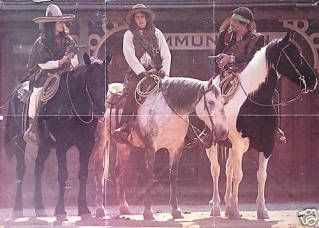
The Jimi Hendrix Experience were
portrayed as cowboys for this poster
included in their "Smash Hits" album.
By STEVE SEYMOUR
If you're a music fan, chances are you've been intrigued by posters, too.
Attention-grabbing and graphically pleasing, posters are just as collectible as records or compact discs.
The first music-related posters I owned came inside record albums. Record companies began to add posters to their LPs to give customers added value for their money in a competitive market.
When "Smash Hits" by the Jimi Hendrix Experience appeared in June of 1969, the package included a poster of the group on horses, portrayed as cowboys in the old West.
Hendrix, bassist Noel Redding and drummer Mitch Mitchell had been photographed by Ed Thrasher on the back lot at the Warner Brothers studio in Los Angeles.
Thrasher, art director for Warner's record division, took photographs during a full-day's session two months earlier for the album's cover artwork.
The images were meant to mimic "Gunsmoke," a popular television series at the time.
The large poster found its way onto the walls at record shops and fans' bedrooms around the country and helped cement Hendrix' reputation as an iconic singer, songwriter and guitarist.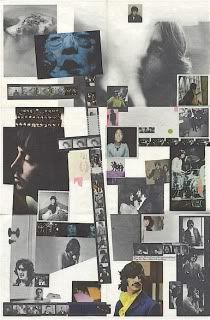
Just months earlier the Beatles offered a free poster in their double LP commonly known as the "White Album." Pop artist Roy Hamilton had suggested the group include an elaborate poster to make-up for the lack of graphics on the record cover he had designed.
Paul McCartney gathered the photos which were used for the poster, measuring 23 by 34 inches. The resulting collage included a drawing of John Lennon & Yoko Ono, Ringo Starr with "Candy" co-star Ewa Aulin, George Harrison with Maharishi Mahesh Yogi, recently-deceased manager Brian Epstein, and dozens of other snap shots.
The reverse side had lyrics for 28 of the album's 30 songs and writing credits. Also included in the album were the now-familiar individual color portraits of McCartney, Lennon, Starr and Harrison taken by John Kelly.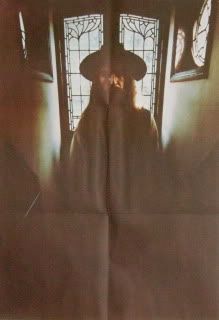
Harrison continued the poster tradition when he released his "All Things Must Pass" in late 1970. The triple-album box set contained a 24 by 36 inch poster made from a photograph taken by Barry Feinstein of Camouflage Productions.
Looking quite unlike a "mop top" with long hair and beard, Harrison is pictured in a dark corridor in his Friar Park home. The image is barely-lit, with little light coming from windows behind the ex-Beatle.
Former bandmate Lennon, meanwhile, chose the opposite approach for his "Imagine" album, released in 1971. The accompanying poster shows Lennon, playing a white piano, in a white room which served as his home recording studio.
One of the rarest Beatles posters came inside a double record set called "The International Battle of the Century: The Beatles Vs. the Four Seasons."
Released by Vee-Jay Records on Oct. 1, 1964 the two albums were actually a repackaging of "Introducing the Beatles" and "Golden Hits of the Four Seasons." Vee-Jay was a black-owned record label founded in Gary, Indiana, which had licensed early Beatles recordings from the group's British label, EMI. 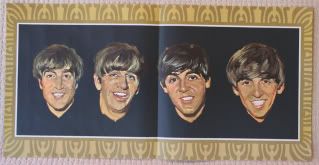
The package contained the two albums and a 12 by 24 inch poster. The poster is an artist's depiction of the faces of the young Beatles on a black background, surrounded by a garish green frame.
The art was actually adapted from a Vee-Jay picture sleeve for the 45 rpm single, "Do You Want to Know a Secret"/"Thank You Girl." No artist credit for the drawing is given.
Fans of the Four Seasons hoping for a poster of their favorite group were left empty-handed.
Valued at about $200 today for the poster alone, I was lucky enough to pick up a copy of the record and artwork in the early 1970s for about $20.
Not to be outdone by their contemporaries, British rock band Pink Floyd issued two posters with their classic album, "Dark Side of the Moon." 
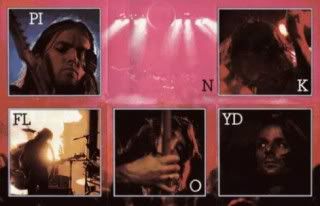
Released in March, 1973 one poster showed the Great Pyramids of Giza taken on infrared film, while the other displayed photos of Pink Floyd in concert. The second poster had the letters to the band's name scattered over the images. Jill Furanovsky, Aubrey Powell and Storm Thorgerson took the photographs.
"Dark Side of the Moon" became one of the best-selling albums in rock history.
Paul McCartney's band Wings countered with two posters in the "Venus and Mars" album, released by Capitol Records in 1975. Each measured 20 by 30 inches in size.
One poster shows McCartney and wife Linda at the foot of Canal Street in New Orleans with the Tuxedo Brass Band during a riverboat party. The photo was taken by Sylvia de Swaan. The second poster, shot by Powell in northern California, features Wings posing in front of an old building.
The Pink Floyd and McCartney albums both used graphics assembled by Hipgnosis, an art design firm founded by Powell and Thorgerson.
The refracting prism design on the cover of "Dark Side of the Moon" brought Hipgnosis international fame. They later did artwork for Led Zeppelin, Black Sabbath, AC/DC, Yes and many other well-known rock acts.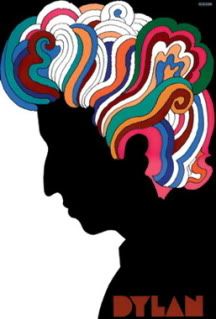
One of the most coveted posters came in "Bob Dylan's Greatest Hits," released by Columbia Records in 1967.
Measuring 33 by 22 inches, the poster shows Dylan's profile in black. His curly hair is multi-colored and an instant reminder of the psychedelic era.
The Dylan artwork was created by graphic designer Milton Glaser. Glaser also designed the "I Love New York" logo.
Back in the day, buying a record album from the likes of Jimi Hendrix, Pink Floyd, the Beatles or Bob Dylan which also contained a poster was a pleasant bonus.
Today those posters bring back memories and have an nostalgic appeal beyond any monetary value.

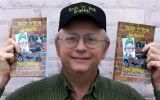
 I've enjoyed rock music and writing since I was a teenager in the 60s. I feel lucky to have been around when rock's greatest stars created their most enduring hits. At the same time I found I enjoyed writing, as well. I worked on my high school newspaper and magazine, was editor of several college publications and earned a bachelor's degree from Central Michigan University in 1973. I worked for the daily newspaper in my hometown after graduating, becoming managing editor after a few years. By the 1980s, I moved into public relations. In 1985, my wife Sue and I opened a retail music store, The Record Rack, which we still own. Rock 'n' roll has been integral to me and for the last 2O years I've been earning my living from it even though I don't have a musical bone in my body. In recent years, I've also I edited a small local magazine and launched a micro FM radio station. Now, I'm finally combining my love of writing and rock 'n' roll. I can't sing a note, but I know what I like. I'll tell you all about it when you read on. I hope you have as much enjoyment reading these installments as I've had writing them.
I've enjoyed rock music and writing since I was a teenager in the 60s. I feel lucky to have been around when rock's greatest stars created their most enduring hits. At the same time I found I enjoyed writing, as well. I worked on my high school newspaper and magazine, was editor of several college publications and earned a bachelor's degree from Central Michigan University in 1973. I worked for the daily newspaper in my hometown after graduating, becoming managing editor after a few years. By the 1980s, I moved into public relations. In 1985, my wife Sue and I opened a retail music store, The Record Rack, which we still own. Rock 'n' roll has been integral to me and for the last 2O years I've been earning my living from it even though I don't have a musical bone in my body. In recent years, I've also I edited a small local magazine and launched a micro FM radio station. Now, I'm finally combining my love of writing and rock 'n' roll. I can't sing a note, but I know what I like. I'll tell you all about it when you read on. I hope you have as much enjoyment reading these installments as I've had writing them.


2 comments:
I have that Dylan poster. When I was stationed in Germany, I brought home many German concert Posters. Kept them for a long time and finally sold them on eBay for pretty good money.
I have the Hendrix Poster, found it in an old garage.
Post a Comment